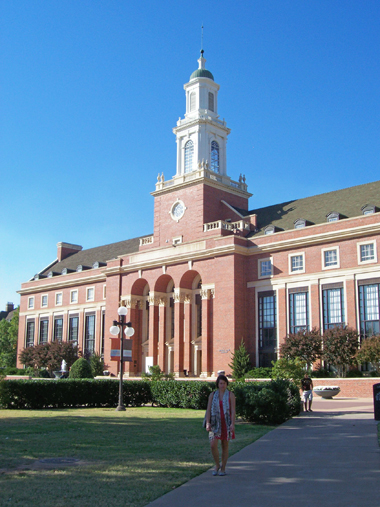These Walls: OSU's Edmon Low Library
Friday, October 15, 2010
By Kirby Lee Davis for The Journal Record
Kirby Lee Davis is the Tulsa Bureau Chief for The Journal Record. Contact him at
918-295-4982

STILLWATER – It represented the first building block in President Henry Bennett’s grand vision to elevate Oklahoma A&M College, creating a new centerpiece for his expanded Stillwater campus.
Although it proved the last building on that 1920s list to materialize, requiring a special street-change dispensation from the Legislature for its 1953 completion, the Edmon Low Library fulfilled all of Bennett’s dreams and more.
“It’s certainly achieved becoming the focal point of the campus,” said Nigel Jones, university architect in OSU’s Long Range Facilities Planning Department.
He credited that in part to a number of classical architecture elements:
• The library’s beautiful Georgian entryway overlooking what became OSU’s central
lawn, capped by an eight-story tower embraced as OSU’s iconic brand.
“It’s the second-most photographed building on campus,” said David Peters, the library’s
coordinator of special collections. “And over the last 50 years, it’s probably the
most photographed.”
• The polished marble staircase and columns adorning the library’s art deco-influenced
lobby.
“This grand staircase is easily one of the most recognizable areas of the library,”
said Senior Communications Specialist Bonnie Ann Cain.
• Its twin two-story meeting rooms, each the size of a gymnasium, providing OSU’s
ideal study hall and banquet area.
“We’re really trying to build communities in the library,” said Peters, noting the many different areas encouraging gatherings and discussions.
That environment started with then-head librarian Edmon Low’s revolutionary “open stacks” strategy. Instead of having a central reference desk where students requested books, his six-floor, 170,760-square-foot library employed open floor plans that granted students complete access.
“He was the one who came up with this whole idea of open shelves, open stacks,” Peters said of Low, who ran the OSU library from 1940 to 1967. “That was his vision for changes in the library world. That’s why he worked so closely with Phil Wilber and Bennett in the design of this thing.”
That strategy was extended under a 68,000-square-foot addition completed in 1968 by Builders Construction Co. of Oklahoma City.
“This was one of the first libraries of that scale to do open stacks,” said Peters. “Of that scale we were on the cutting edge.”
Built of concrete, steel and brick, Jones said the original design by two architectural firms – Sorey, Hill and Sorey and Phil Wilber and Associates – provided a flexible foundation for growth. Peters also credited that to Bennett, who during the groundbreaking realized the plotted land did not allow enough northern room for future expansion. So after the ceremony ended and everyone left, he personally moved the foundation stakes forward to the library’s current site.
“It was the key to Bennett’s plan,” he said of the 1950 event. “He then died the next year, so he never saw it.”
Since its opening, the Low library has grown from about 400,000 volumes to 3 million, with increased computer access, wireless Internet and power cables for today’s digital age. A marble fountain charms visitors as they listen to electronic bell music ringing from the tower, its white spire brightened by color-changing light-emitting diodes. Plush lounge chairs await those who seek out the fourth floor, considered the best for sleeping through one’s stressful studies.
“It kind of holds the history, the heart of the university,” said Carrie Hulsey-Greene, associate director of OSU Communications. “You always walk a little taller when you walk closer to the library.”
And yet, in adapting to today’s electronic services, more and more library users find no longer need to visit the iconic building to tap its wealth of knowledge.
“They visit the library in different ways than we would have ever imagined,” said Peters.
And in that, too, Peters said Bennett’s centerpiece plays a continuing community role, as the foundation for what’s to come.
“For us, the library is really bigger than the building now,” he said. “We are no longer restricted to that facility. It’s a jumping-off point for a lot of things.”
